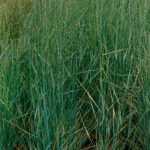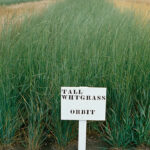Herbe à blé haute
Thinopyrum ponticum
General Description
Tall wheatgrass is a long-lived, tall, perennial bunchgrass. It is most often used for rehabilitation of moist or flooded saline areas as it is a top saline tolerant species. It can also be found on dry roadsides and slopes. It has an extensive fibrous root system that can grow 300 cm (118 in.) into the soil. Plants form a “bunch” that increases in size with age.
Tall wheatgrass stems are coarse and grow 100 to 300 cm tall (39 to 118 in.). Short leaves are found up the stem. Long leaves grow from a basal bunch. Leaves are 2 to 6.5 mm wide with short hairs that make them scratchy to the touch. Leaves remain green late into the growing season. The seed heads can be over 30 cm (12 in.) in length and form a stiff narrow spike, with long gaps between spikelets. Seeds are large and do not shatter easily.
Type
Tame grass.
Origin
Saline meadows of Southern Russia. Varieties have been developed in Canada.
Longevity
At least 20 years. Tall wheatgrass is long lived under ideal growing conditions, but dry conditions, such as found in the Brown soil zone, shorten its lifespan (at least 10 years longevity).
Use
Pasture, hay, reclamation. Tall wheatgrass is primarily used for saline area reclamation, but may then be used off those saline areas for pasture or hay.
Optimal Time of Use
Summer. Tall wheatgrass begins growing in early spring but is slow to grow. It is often grown in moist areas that would be sensitive to early use. Hay before heading for best palatability as it becomes coarse once mature. Tall wheatgrass is best grazed before the stems elongate when most growth is basal, leaving 15 cm (6 inches) of growth post-grazing. Once stems grow, tall wheatgrass becomes coarse and avoided by livestock.
Recovery After Use
Recovery after use is slow for tall wheatgrass. In most situations, tall wheatgrass is best used once per year, but may only need 60-80 days of recovery in the higher rainfall soil zones.
Palatability/Nutritional Value
Palatable before stems elongate (heading). Livestock may select against tall wheatgrass in mixes at any stage. Leaves are notably tough. Tall wheatgrass has an average early season digestibility of 47% and crude protein of 10.6% .
Annual Precipitation min/max (mm)
250 mm / 700 mm
Drought Tolerance
Fair tolerance. While tall wheatgrass can live through drought periods, it cannot survive through very dry conditions.
Flooding Tolerance
Tall wheatgrass can withstand up to 5 weeks of flooding in spring. It has good tolerance for excess soil moisture and grows best in moist soils.
Winter Hardiness
Good hardiness. Hardiness is not noted as a concern with tall wheatgrass even though it is less hardy than some grasses such as crested wheatgrass, Kentucky bluegrass, and creeping red fescue.
Soil Texture Preference
Tall wheatgrass prefers loam to clay moist soils. It can tolerate high water tables.
Erosion Control
Very little erosion control. Tall wheatgrass is sometimes used for roadside ditches, but is a large bunchgrass and does not spread outwards.
Salinity Tolerance
High tolerance. Tall wheatgrass has the highest salt tolerance of all introduced agronomic grass species (green wheatgrass is considered equal).
Acidity Tolerance
Low tolerance.
Alkalinity Tolerance
Low to moderate tolerance.
Seeds per kg
166,000 seeds/kg (75,000 seeds/ lb)
Suggested Mixtures
Seed tall wheatgrass for saline site reclamation. Seed the most saline areas to a pure stand or best mix with other moderately saline tolerant species such as slender wheatgrass, dahurian wildrye, tall fescue, smooth bromegrass and intermediate wheatgrass or pubescent wheatgrass. Saline tolerant varieties of alfalfa can be included in the mix as they will establish where it is less saline. When used in a mixture, livestock may select against tall wheatgrass as it matures.
Ease of Establishment
Tall wheatgrass is slow to germinate and seedlings do not compete well with weeds. Two years are recommended for establishment before use, especially in harsh areas such as saline soils.
Competitiveness
Tall wheatgrass is competitive in saline soils once it is established. It does not usually reseed itself and is not considered invasive.
Management Considerations
Effective weed control may be necessary for establishment as tall wheatgrass seedlings may take two years to fully establish. Irrigation and fertilization can enhance production. While tall wheatgrass has high salinity tolerance it does not grow well on dry sites.
content reference: British Columbia Rangeland Seeding Manual, Saskatchewan Dryland Forage Species Adaptation Tool, USDA Plants Database, Alberta Forage Manual, Manitoba Forage Adaptation and Comparison Guide.
Tall wheatgrass is not adapted to the main zones of the Central Interior, i.e, the Sub-Boreal Spruce, Interior Cedar-Hemlock and Sub-Boreal Pine–Spruce zones. In the southern part of the region it is adapted to the less-arid parts of the Bunchgrass zone and the Interior Douglas-fir zones.
Tall wheatgrass is adapted to less-arid parts of the Bunchgrass zone, and the Ponderosa Pine and Interior Douglas-fir zones.

